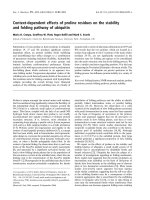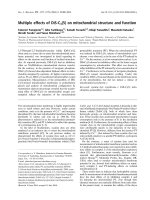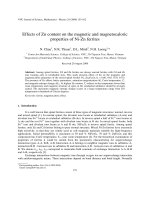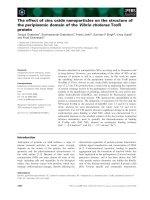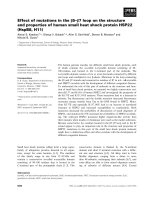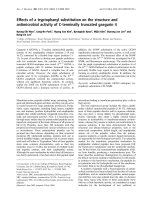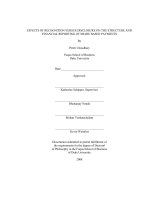effects of recognition versus disclosure on the structure and financial reporting of share based payments
Bạn đang xem bản rút gọn của tài liệu. Xem và tải ngay bản đầy đủ của tài liệu tại đây (508.55 KB, 103 trang )
EFFECTS OF RECOGNITION VERSUS DISCLOSURE ON THE STRUCTURE AND
FINANCIAL REPORTING OF SHARE BASED PAYMENTS
By
Preeti Choudhary
Fuqua School of Business
Duke University
Date:_____________________________
Approved:
_________________________________
Katherine Schipper, Supervisor
_________________________________
Dhananjay Nanda
_________________________________
Mohan Venkatachalam
_________________________________
Kevin Weinfurt
Dissertation submitted in partial fulfillment of
the requirements for the degree of Doctoral
of Philosophy in the Fuqua School of Business
of Duke University
2008
UMI Number: 3297727
3297727
2008
UMI Microform
Copyright
All rights reserved. This microform edition is protected against
unauthorized copying under Title 17, United States Code.
ProQuest Information and Learning Company
300 North Zeeb Road
P.O. Box 1346
Ann Arbor, MI 48106-1346
by ProQuest Information and Learning Company.
Copyright by
Preeti Choudhary
2008
ABSTRACT
EFFECTS OF RECOGNITION VERSUS DISCLOSURE ON THE STRUCTURE AND
FINANCIAL REPORTING OF SHARE BASED PAYMENTS
By
Preeti Choudhary
Fuqua School of Business
Duke University
Date:_____________________________
Approved:
_________________________________
Katherine Schipper, Supervisor
_________________________________
Dhananjay Nanda
_________________________________
Mohan Venkatachalam
_________________________________
Kevin Weinfurt
An abstract of a dissertation submitted in partial
Fulfillment of the requirements for the degree of
Doctoral of Philosophy in the Fuqua School of Business
of Duke University
2008
iv
Abstract
I examine whether financial statement preparers (managers and auditors) treat
recognized versus disclosed fair value of option compensation differently. Recognition
refers to items that appear on the face of financial statements and that are included in
subtotal figures that appear in the summary accounts; disclosure refers to items that
appear in words and amounts in only the financial statement footnotes. I find that fair
value recognition of option compensation is likely to have a significant impact on net
income. Firms in my sample granted options amounting to a median fair value of 7% of
profits in 1996 and 11% of profits in 2004. I compare the terms of option grants and the
properties of fair value estimation under a disclosure reporting regime to terms and
properties under a recognition regime. Under a fair value recognition regime, I find firms
reduce/eliminate option grants across all levels of employees, reduce the statutory length
of options, and substitute restricted stock and bonuses for option compensation. The fair
value reduction in option grants is on average 9% (0.4%) of absolute net income. In
contrast, under a fair value disclosure regime, option compensation was not reduced. I
also find that firms increase the bias in three inputs to fair value option estimation:
volatility, dividend, and interest. This increase amounts to 4%, 2%, and 0.3% of fair
value cost. Mandatory recognition firms also display increased dividend and interest
input accuracy. Combined, these results suggest that financial statements reflect
differences in behavior between recognition and disclosure reporting regimes, such that
both real actions and fair value estimation are used to reduce recognized values.
v
Table of Contents
Abstract iv
List of Tables vii
List of Figures viii
1. Introduction 1
2. Prior Research 8
2.1 Prior Research on Real Actions 8
2.2 Prior Research on Estimation and Reliability 11
3. Hypotheses 15
3.1 Changes in Option Terms during Disclosure (H1) and Recognition (H2) 15
3.2 Differences in Reliability of Estimates under Recognition and Disclosure (H3) 19
4. Research Design 22
4.1 Tests for Structural Changes in Option Compensation (H1 and H2) 22
4.2 Tests for Reliability Differences between Recognition and Disclosure 27
5. Sample Selection and Results 37
5.1 Sample Selection for Structural Changes in Option Compensation 37
5.2 Empirical Results for Structural Changes in Option Compensation 40
5.3 Alternative Explanations 52
5.3.1 Differences in Sample Composition Overtime 52
5.3.2 Reductions in Executive Compensation 54
5.3.3 Differences between Treatment and Control Firm Characteristics 55
vi
5.3.4 Declining Volatility 60
5.3.5 Other Time Period Issues 62
6. Analysis of Differences in Reliability under Recognition versus Disclosure 66
6.1 Sample Selection for Tests of Reliability Differences 66
6.2 Empirical Results for Reliability Differences 70
6.3 Sensitivity Analysis 78
6.3.1 Implied Volatility as a Benchmark 78
6.3.2 Analysis using Daily Historical Volatility 80
6.3.3 Using Squared Deviations to Measure Accuracy 82
6.3.4 Changing Weights on Implied and Historical Benchmarks 84
7. Conclusions and Limitations 86
Appendix 1: Variable Definitions for Reliability Analysis 88
References 89
Biography 94
vii
List of Tables
Table 1: Sample Descriptive Data for Tests of Changes in Option Terms 38
Table 2: Mean and Median Changes in Option Terms 41
Table 3: Time Series Analysis of Changes in Option Grants across Employees 46
Table 4: Substitution among Various Forms of CEO Compensation 48
Table 5: Cross-Sectional Analysis of CEO Equity Structure 51
Table 6: Comparison of Recognition and Disclosure Changes in Equity Grants 54
Table 7: Matched Sample Analysis 57
Table 8: Changes in Option Grants Comparing Recognition and Disclosure 63
Table 9: Sample Description for Analysis of Reliability Differences 67
Table 10: Pearson\Spearman Correlations for Reliability Analysis 71
Table 11: Reliability Analysis for Mandatory and Voluntary Recognition 75
Table 12: Volatility and Interest Reliability using Alternate Time Period Controls 77
Table 13: Reliability Analysis using Implied Volatility 79
Table 14: Analysis of Volatility Reliability using Daily Compounding 81
Table 15: Using Squared Deviations (Bias
2
) to Measure Accuracy 83
Table 16: Tests for Changing Weights on Volatility Benchmarks 85
viii
List of Figures
Figure 1: Time Series of Changes in Accounting Standards 5
Figure 2: Volatility, Interest Rate, and Dividend Yields from 1976 to 2006 36
Figure 3: Number of Options Granted Overtime, Complete Sample 61
Figure 4: Changes in Options Granted, Matched Sample 65
1
1. Introduction
I compare the compensation contracts (specifically, the number of employee stock
options or ESOs and their terms) and the properties of inputs used to estimate ESO fair
values, under a disclosure-only financial reporting regime versus a recognition regime.
1
The purpose is to understand how recognition versus disclosure in financial reporting
affects both real actions—the number of ESOs granted and their contractual terms—and
financial reporting decisions—managements’ estimates of volatility, dividend yield and
interest rates used to calculate the fair value of ESOs. For a large sample of firms
included in the EXECUCOMP database during 2004 to 2005, I find evidence that, once
firms are required to recognize the fair values of ESOs in the financial statements, firms
reduce ESO grants by an average (median) of 9% (0.4%) of absolute net income. I also
find that, relative to benchmarks, firms reduce their estimates of volatility, dividend yield,
and interest rates by 4%, 2% and 0.3% of fair value cost, respectively.
I study the impact of accounting policy on ESOs, a common form of share-based
compensation. This topic is important for several reasons. First, firms pay a large
amount of compensation. Bebchuk and Grinstein [2005] report that total compensation
(not just ESOs) paid to the top five executives represents approximately 9.4% of profits
in 2003 for the average firm in the Execucomp database and point to an increasing trend
in the level of executive compensation over the last decade. Firms in my sample
1
Recognition is “depiction of an item in both words and numbers, with the amount included in the totals of
the financial statements;” disclosure requires items to be presented only in the footnotes (FASB Concepts
Statement No. 5 paragraph 9).
2
disclosed median fair value of option costs (to all employees) amounting to 7% of profits
in 1996 and 11% of profits in 2004. Second, investors, the media, and regulators focus
much attention on executive pay; thus, changes to required compensation disclosure are
likely to continue. Third, the overall effect of preparers’ incentives under recognition
versus disclosure regimes is not well understood. Most existing research that investigates
differences between recognition and disclosure focuses on differences in market
perceptions of reported versus disclosed values, not whether the values themselves have
different properties. Finally, documentation of recognition and disclosure differences
may help standard setters and regulators understand how decisions about information
placement affect behaviors.
As Schipper [2007] states, we lack a comprehensive theory of required disclosure
which might identify an objective of disclosure and provide a theoretical basis for
distinguishing recognition from disclosure. Generally accepted accounting principles
(GAAP) do not clearly distinguish recognition from disclosure. Although Statement of
Financial Accounting Concepts No. 5, Recognition and Measurement in Financial
Statement of Business Enterprises (paragraph 63), identifies four necessary criteria for
recognition: items must meet the definition of a financial statement element, and be
measurable, relevant, and reliable, neither Concepts Statements nor any other component
of the Financial Accounting Standards Board (FASB) states a disclosure objective. I am
also unable to identify auditing standards which indicate that auditors should treat
recognized items differently from disclosed ones.
3
Despite the absence of a specific theoretical, auditing, or financial reporting
distinction, it appears that participants in the financial reporting process view recognition
and disclosure differently. For example, Concepts Statement 5, paragraph 9 states
“disclosure by any other means is not recognition,” indicating that the Financial
Accounting Standard Board (FASB) does not view recognition and disclosure as
substitutes. In the context of accounting for share based payments, Espahbodi,
Espahbodi, Rezaee, and Tehranian [2002] find significant abnormal returns around the
issuance of the FASB’s 1993 and 1994 exposure drafts. The former proposed fair value
recognition of stock compensation, and the latter proposed a free choice between fair
value disclosure and fair value recognition of stock compensation. The evidence of
negative (positive) abnormal returns documented around the 1993 (1994) proposal
implies investors view recognition and disclosure differently.
There is also evidence that managers and auditors, who prepare and review
financial statements, view recognition and disclosure differently. Libby, Nelson, and
Hunton [2006] find significant differences in auditor permitted misstatements for
recognized versus disclosed fair value estimates, suggesting auditors treat the two
differently. Libby et al. [2006] also find auditors believe managers will be more resistant
to correcting misstatements in recognized versus disclosed compensation cost, indicating
managers might also view them differently. Choudhary, Rajgopal, and Venkatachalam
[2007] identify approximately 400 announcements for accelerated vesting of employee
stock options (ESOs) where 80% of accelerators state avoiding recognition of fair value
compensation expense as one reason for accelerating vesting periods.
4
The implications of recognition versus disclosure are difficult to test due to
institutional constraints (Bernard and Schipper [1994]). Few settings permit comparisons
between recognition and disclosure. Those that do often suffer from one of three
following issues: simultaneous changes in the valuation of the transaction and
recognition; differences in the information quantity (i.e. firms disclose range estimates,
but recognize point estimates and provide estimation details); or self-selection problems
(firms can choose to recognize/disclose). I contribute to existing research about
recognition and disclosure by investigating a setting which overcomes these limitations.
Four institutional features make Financial Accounting Standard (FAS) 123/123-R
a good setting to investigate questions about recognition versus disclosure. First, these
pronouncements provide for a transition from no disclosure to disclosure of ESO fair
values and a transition from ESO fair value disclosure to ESO fair value recognition.
Prior to FAS 123, firms valued ESOs at their intrinsic value under Accounting Principles
Board (APB) Opinion No. 25.
2
ESOs issued to employees under fixed plans were not
required to be remeasured. Firms that issued fixed plan, at-the-money options to their
employees recognized zero ESO costs. Passed in December 1995, FAS 123 required fair
value disclosure of ESOs, and permitted fair value recognition as the preferred alternative
to recognizing intrinsic value.
3
The FASB passed FAS 123-R in December 2004,
2
The intrinsic value is the difference between the instrument’s exercise price and the market price. In
contrast, fair value takes into consideration the time value of the option.
3
FAS 123 required firms to disclose the fair value stock compensation costs, pro forma net income
including fair value costs (net of tax effects), and the pro forma basic and diluted EPS.
5
requiring fair value recognition of ESOs.
4
These sequential changes (depicted in Figure
1) allow me to compare the effects of valuation and recognition changes separately.
Figure 1: Time Series of Changes in Accounting Standards
Second, both FAS 123 and FAS 123-R require similar disclosures about inputs to
fair value estimates, number of options granted, fair value cost, the fair value estimation
method used, and the guidance to estimate fair values is similar under both regimes. This
limits both changes in the quantity of information and differences in estimation
techniques as potential explanations of differences identified. Third, some firms
voluntarily recognized fair value option cost under FAS 123. Voluntary recognizers are
not affected by FAS 123-R, rendering them a useful control for time period effects. Time
period controls are important because the accounting changes are synchronous. Lastly,
authoritative guidance (FAS 123, FAS 123-R, and Staff Accounting Bulletin (SAB) 107)
identifies publicly available firm-specific and time-specific benchmarks as bases for
4
FAS 123-R requires fair value recognition of stock compensation cost and permits choices about
aggregation and presentation. Some firms delineate stock compensation cost on the face of the income
statement, while others pool the cost as part of research and development, cost of sales, or sales, general
and administrative expenses. In a conventional (indirect) cash flow statement, stock compensation cost is a
non-cash item added to net income. Thus, all firms separately list fair value ESO expense in the statement
of cash flows and in the footnotes to the financial statements.
12/94: FASB
amends to
disclosure
10/95: FAS 123
issue date, requiring
fair value disclosure
12/95: FAS
123 effective
6/05: FAS 123-
R effective date
12/04: FAS 123-R
issue date, requiring
fair value recognition
6/93: Exposure
draft, fair value
recognition
6
reasonable estimates of fair value compensation cost, allowing me to investigate the
properties of firm-specific estimates relative to these benchmarks.
I test for changes in the structure of compensation by analyzing time series
changes in the terms of option contracts and for substitution towards other forms of
compensation. I focus primarily on changes in the number of option grants because these
changes are likely to have the largest impact on fair value. For a sub-sample of firms
with sufficient data, I also report changes to other terms of option contracts: the
moneyness of options and the contractual length.
5
Where possible, I conduct the
changes analysis for employees at different levels – the CEO, executives, and rank and
file employees. I find that firms modify the terms of compensation contracts at the time
of mandated recognition, but not during mandated disclosure. Firms reduce the
recognized fair value of ESOs in two ways: by eliminating or reducing option grants and
by reducing the contractual length of options.
I also investigate whether inputs used to estimate fair value compensation cost
differ in reliability under recognition versus disclosure. I define reliability as the ability
to verify three input assumptions (volatility, interest rate, and dividend yield) with an
external, objective source. I consider two aspects of reliability, bias and accuracy, by
comparing reported volatility, dividend yield, and interest rate inputs to historical/implied
volatility, historical dividend yield, and implied interest rate benchmarks identified in
FAS 123, FAS 123-R, and SAB No. 107. When I compare recognized fair values inputs
5
Moneyness is the relation between the market stock price (on the grant date in my paper) and the exercise
price of the option.
7
to disclosed fair value inputs, the distribution of all three estimates shifted to the left of
the benchmark, consistent with managerial incentives to maximize net income. The
comparison also indicates that the dividend and interest (volatility) inputs exhibit
decreased (unchanged) dispersion from the benchmarks.
The dissertation is organized as follows: Chapter 2 discusses contributions to
existing research. Chapter 3 discusses the hypotheses tests. Chapter 4 discusses research
design. Chapter 5 discusses the sample and empirical results for tests of changes in the
number and terms of ESOs, while Chapter 6 discusses the sample and empirical results of
tests for differences in reliability under recognition and disclosure. In Chapters 5 and 6, I
also include several sensitivity analyses. Chapter 7 concludes and discusses limitations
of the research.
8
2. Prior Research
My research addresses two questions about recognition and disclosure
differences. The first investigates real actions managers take to structure transactions in
response to accounting changes. The second investigates differences in values estimated
by managers and verified by auditors. Prior accounting research has investigated both
real actions and financial reporting decisions in the context of recognition and disclosure.
Examples of the former include Imhoff and Thomas [1988] and Mittelstaedt, Nichols,
and Regier [1995]; examples of the latter include Davis-Friday, Liu, and Mittelstaedt
[2004], Ahmed, Kilic and Lobo [2006], and Libby et al. [2006]. If preparers treat
recognition and disclosure differently, these differences can exist through both real
actions and estimation.
2.1 Prior Research on Real Actions
Prior research provides evidence that managers take different actions when values
are recognized versus disclosed. Subsequent to FAS 13, which required balance sheet
recognition of capital leases, Imhoff and Thomas [1988] find that lease structures change;
firms substituted capital leases with operating leases and non-lease financing. Within one
year of adopting FAS 106, which required recognition of the unfunded retiree health care
benefit liability, Mittelstaedt, Nichols and Regeir [1995] find that 35.1% of their sample
reduced health care benefits. Although this research provides evidence of changes in the
structures of business transactions at the time of accounting changes requiring
recognition, both settings involve simultaneous changes in both the valuation method and
9
the recognition of those values on the face of financial statements. In these settings,
disclosure provides a different quantity and quality of information. In contrast, the
evolution of accounting standards resulting in FAS 123/123-R isolates valuation changes
from placement changes. FAS 123 mandates changes in valuation from intrinsic value to
fair value; FAS 123-R shifts the location of the fair value from the footnotes to the
financial statements. Thus, I am able to isolate the effects of valuation and placement. I
also contribute to existing research by comparing the effects of changes in valuation and
changes in placement; prior settings studied do not permit such analysis.
I add to existing literature that investigates whether the favorable accounting
treatment of ESOs affected their use. Prior research investigating this question yields
mixed evidence. After controlling for other factors, Aboody, Barth, and Kasnik [2004]
find no relation between decisions to recognize ESO fair values and the magnitudes of
ESO fair values. Yermack [1995] finds no association between financial reporting cost
(proxied by interest coverage) and stock option grants (proxied by the partial derivative
of the Black Scholes value with respect to price times the fraction of equity granted in
options). In contrast, Matsanuga [1995] finds a weak positive relation between the use of
income-increasing accounting methods and the probability of issuing stock options as
opposed to other equity incentives. These papers test the influence of favorable
accounting treatment by relating cross-sectional differences in option granting policies to
cross-sectional differences in financial reporting sensitivity. My setting tests for
compensation changes during the mandated removal of the accounting subsidy for ESOs,
10
a better setting because it does not suffer from measurement error of or incomplete
proxies for financial reporting costs.
Three recent papers (Carter et al. [2006], Johnston and Rock [2006], and Brown
and Lee [2007]) examine the effect of accounting treatment on compensation contracts.
Carter et al. [2006] find voluntary recognizers shift CEO compensation from options
toward restricted stock. Johnston and Rock [2006] find that voluntary recognizers reduce
the number of stock option grants for both executives and rank and file employees.
These two papers study changes in compensation contracts following voluntary
recognition of ESOs fair values under FAS 123. One disadvantage of the voluntary
setting is that it suffers from endogeneity; firms are choosing both the terms of option
contracts and whether to adopt fair value recognition. Second, investor and market
sentiments about option compensation also changed during the time period of most
voluntary recognition decisions (Bartov and Hayn [2007]). Investigating changes in
compensation contracts subsequent to mandated GAAP changes (also subsequent to
changes in market sentiments about options) confirms whether the accounting treatment
affects compensation.
According to Brown and Lee [2007], firms on average reduced the proportion of
executive option compensation during mandatory fair value recognition. They also find
that debt covenants, relatively high numbers of unvested options, firms that accelerated
option vesting prior to recognition, and firms with higher propensities to meet prior year
earnings are associated with greater reductions in the proportion of option compensation.
My paper differs in three ways. First, I examine the terms of compensation contracts
11
(e.g., the number of options granted, contractual length and moneyness), whereas Brown
and Lee [2007] test for changes in compensation contracts through percent changes in
fair value of options as a percent of total compensation. This measure conveys an
incomplete picture of the economic consequences of recognition because firms may
increase other forms of compensation irrespective of changes in options, biasing the
measure towards finding reductions in option usage. Secondly, managers do not control
concurrent changes in fair value parameters (e.g. level of stock price, volatility, or
interest rates). Measuring ESO policy changes through fair value biases towards finding
reductions in option grants due to significant declines in volatility during mandatory
recognition.
1
Alternatively, testing for changes using the number of options granted
biases against finding option reductions to the extent that option grants based on fair
values (Murphy [1999]). Lastly, my analysis differs because Brown and Lee [2007]
analyze only executive options, whereas I examine option contracts across different
levels of employees. Since most opposition to option compensation is focused at the
executive level, evidence of changes in rank and file employee option grants provides
stronger support that such changes are not due to changing investor sentiments about
executive compensation.
2.2 Prior Research on Estimation and Reliability
The second research question is whether recognized versus disclosed fair value
estimates differ in reliability. Several prior researchers address this question by
1
Evidence of volatility declines during mandatory recognition appears in Figure 2; Table 9 Panel
C reports that historical volatility declined by approximately 10%.
12
investigating the pricing consequences of recognized and disclosed values. Davis-Friday,
Liu, and Mittelstaedt [2004], Ahmed, Kilic, and Lobo [2006], Aboody [1996], and
Balsam, Bartov, and Yin [2005] investigate the relation between the market value of
equity and the recognized/disclosed financial item (post retirement benefits, derivatives,
asset write downs, and stock compensation expense respectively) using the market price
and a specified valuation model to test whether the valuation coefficient on the specified
financial item differs between recognition and disclosure. Alternatively, Frederickson,
Hodge, and Pratt [2006] use an experimental approach to identify differences in
perceived reliability of values subject to differential accounting treatment. Users
perceived significant decreasing reliability assessments across mandatory recognition,
voluntary recognition, and mandatory disclosure.
This research investigates whether investors perceive differences in recognized
versus disclosed values, but does not address why perceived differences exist. There are
at least three possible explanations for why the perceived differences exist: differences in
processing costs, cognitive biases, and/or actual differences in the quality of information.
I contribute to this literature by testing the third explanation, whether the judgments and
behaviors of preparers (implementation) differ between recognized and disclosed values.
My tests provide indirect evidence on how preparers treat recognized versus disclosed
values.
Results in Libby et al. [2006] imply the possibility of actual differences in
information reliability, based on placement. Libby et al. [2006] find that auditors permit
significantly lower levels of misstatements in recognized values than in disclosed values.
13
However, they also find that auditors believe clients will resist auditor corrections in
recognized values more than in disclosed ones. Given these two results focus on auditors
while controlling for manager behaviors, it remains unclear whether reliability
differences exist between recognized and disclosed items when manager estimation is not
controlled for.
My research also relates to studies that test for earnings management using the
inputs to the Black Scholes model. For example, Aboody, Barth, and Kasnik [2006],
Hodder, Mayew, McAnally, and Weaver [2006], Balsam, Mozes and Newman [2003],
and Bartov, Mohanram, and Nissim [2004] investigate whether managers
opportunistically manipulate fair values of stock compensation cost using input estimates.
They find that managers manipulate disclosed stock option cost downward when
opportunistic incentives exist (i.e., high CEO compensation or poor governance). My
research question differs in two ways. First, I am interested in both bias and accuracy,
while Aboody et al. [2006], Balsam et al. [2003] and Bartov et al. [2004] focus only on
bias. Hodder et al. [2006] consider accuracy, but only with respect to ex post realized
values.
2
Second, these papers investigate cross-sectional differences in disclosed input
assumptions only, whereas I am interested in how both bias and accuracy of the inputs
differ between recognition and disclosure.
The paper that addresses a research question most similar to mine is Johnston
[2006], who tests for increased underestimation in ESO fair values that are voluntarily
2
Ex post realized values are not good proxies for expected values because economic effects can not be
perfectly anticipated. Secondly, FAS 123 states the objective of fair valuation is to estimate the value of
the ESO on the grant date, not the future expected value.
14
recognized in 2002 versus those that are disclosed. My analysis differs from Johnston
[2006] in several ways. First, I test for reliability differences between mandated
recognition and disclosure. The mandatory setting does not suffer from self-selection,
which may affect the increased volatility bias documented in his results. Managers and
auditors might treat voluntary and mandatory recognition differently. Frederickson et al.
[2006] finds that investors perceive differences in reliability between voluntarily
recognized and mandatorily recognized fair value costs. Second, I consider bias and
accuracy in my tests, whereas Johnston [2006] tests for bias only. Third, my analysis
uses different benchmarks to measure reliability. I use implied interest yield on a zero-
coupon government bond and implied volatility in my analysis, whereas Johnston [2006]
uses historical interest rates and historical volatility for his primary analysis.
3
This
difference is important because the FASB (in FAS 123-R) and the Securities Exchange
Commission (in SAB 107) specify both implied volatility and implied interest as
appropriate benchmarks.
3
Johnston uses the average daily interest rate obtained in the previous fiscal year on a US Treasury note,
inconsistent with the benchmark specified by FAS 123. Given interest rates are influenced by time trends,
this could affect his results.
15
3. Hypotheses
In this section, I test for differences between recognition and disclosure in real
actions and estimation. I discuss why recognition and disclosure may be treated
differently by preparers, auditors, and users, but I do not test or provide evidence of why
differences exist (i.e. causal evidence). Tests that would produce causal evidence as to
why recognition and disclosure are different are difficult to conduct because causal
factors and proxies for the factors are not easily identifiable or distinguishable. (Schipper
[2007])
3.1 Changes in Option Terms during Disclosure (H1) and Recognition (H2)
The first hypothesis, stated in null form, is that fair value disclosure of ESOs does
not affect the terms of ESO grants. This might occur if managers and governing boards
who set the terms of ESO grants (hereafter, managers) believe investors are unable or
unwilling to adjust recognized values for the disclosed ESO fair values, or the
information provided by the disclosure is not material. Managers may believe investors
use recognized amounts in their valuation assessments without any adjustments (a variant
of functional fixation) because investors rely on categorical structures to process
information in order to reduce processing costs (see Tinic [1990] for a detailed
discussion).
Alternatively, managers may believe investors view fair value disclosures as
irrelevant because they believe the information about option grants and values in the
proxy statement is adequate. Prior to FAS 123, proxy statements included the number of
16
options granted to the top five executives, the percentage of options granted to each of the
top five executives as a percent of total options granted to all employees, and changes to
the intrinsic value of options corresponding to varying percentage stock price increases.
A few proxy statements also included estimated fair values of executive option grants.
Under FAS 123, firms must disclose in the annual report the total number of options
granted to all employees and the corresponding fair values, along with the estimated
effects on net income.
It is also possible that investors might not rely on the fair value disclosures if they
believe that fair value does not represent the cost of issuing options. Firms might
increase option grants in response to disclosure, if they reduced or withheld option grants
during 1995 because there was uncertainty whether the FASB would require fair value
recognition (see Figure 1). Firms may have granted more options after FAS 123 (in
comparison to the pre period) in order to bring equity incentives to the preferred level.
The first hypothesis, stated in the null form is as follows:
H1
0
: Firms did not change the terms of option grants in response to disclosure of ESO
fair values.
The second hypothesis, stated in null form, is that the placement (i.e., recognition)
of ESO fair values, holding constant the measurement attribute, does not affect the terms
of option grants. Recognition, subsequent to disclosure, would not lead to changes in the
terms of ESOs if managers believe the distinction is not pertinent for decisions related to

